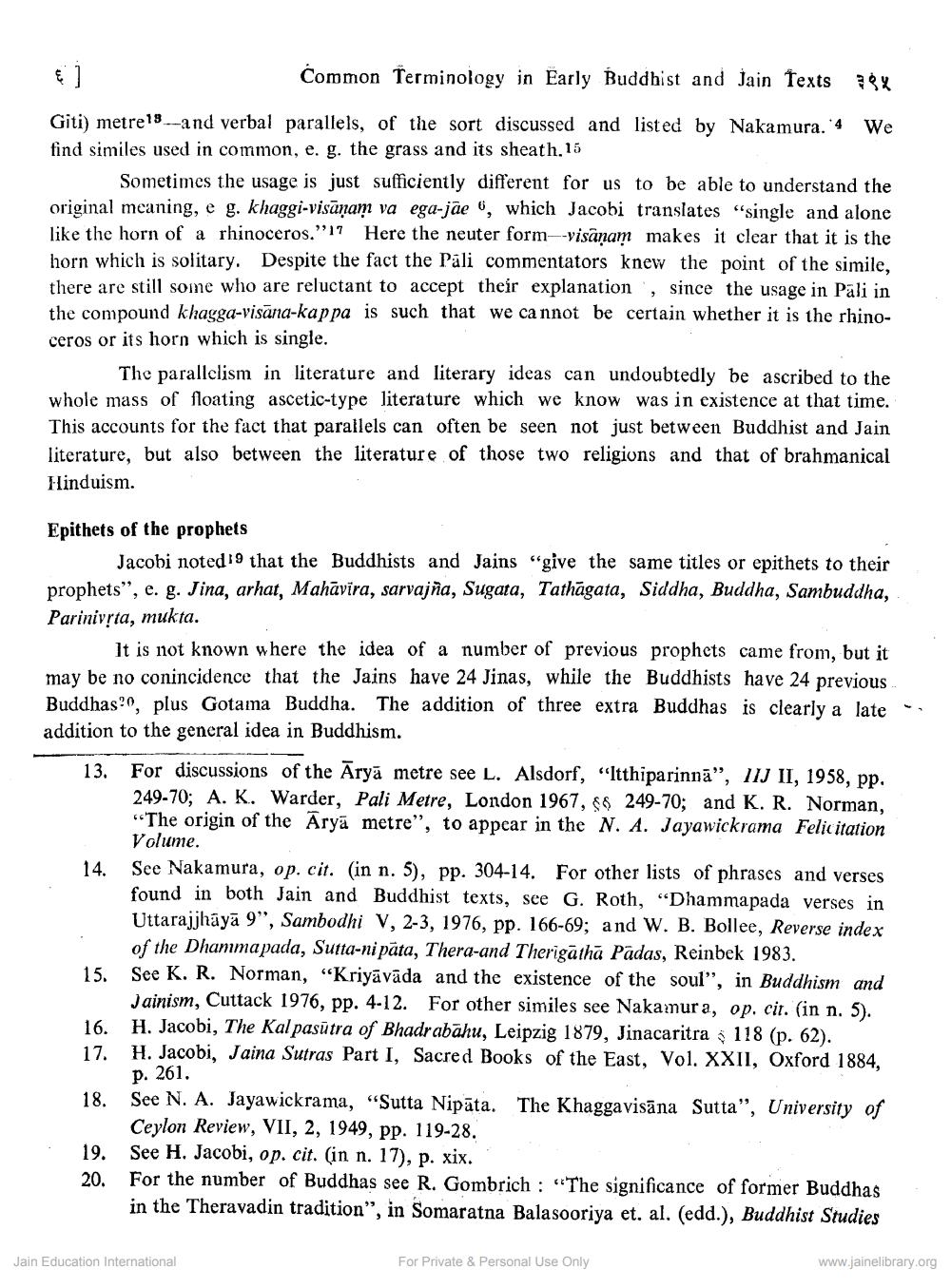________________
Common Terminology in Early Buddhist and Jain Texts
X
Giti) metre18--and verbal parallels, of the sort discussed and listed by Nakamura.'4 We find similes used in common, e. g. the grass and its sheath. 15
Sometimes the usage is just sufficiently different for us to be able to understand the original meaning, e g. khaggi-visānam va ega-jāe , which Jacobi translates "single and alone like the horn of a rhinoceros."17 Here the neuter form--visanam makes it clear that it is the horn which is solitary. Despite the fact the Pali commentators knew the point of the simile, there are still some who are reluctant to accept their explanation', since the usage in Pali in the compound khagga-visāna-kappa is such that we cannot be certain whether it is the rhinoceros or its horn which is single.
The parallelism in literature and literary ideas can undoubtedly be ascribed to the whole mass of floating ascetic-type literature which we know was in existence at that time. This accounts for the fact that parallels can often be seen not just between Buddhist and Jain literature, but also between the literature of those two religions and that of brahmanical Hinduism.
Epithets of the prophets
Jacobi noted 19 that the Buddhists and Jains "give the same titles or epithets to their prophets", e. g. Jina, arhat, Mahavira, sarvajña, Sugata, Tathāgata, Siddha, Buddha, Sambuddha, Parinivsta, mukta.
It is not known where the idea of a number of previous prophets came from, but it may be no conincidence that the Jains have 24 Jinas, while the Buddhists have 24 previous Buddhas?o, plus Gotama Buddha. The addition of three extra Buddhas is clearly a late addition to the general idea in Buddhism.
,
13. For discussions of the Āryā metre see L. Alsdorf, "Itthiparinna", IIJ II, 1958, pp.
249-70; A. K. Warder, Pali Metre, London 1967, $8 249-70; and K. R. Norman,
The origin of the Aryä metre", to appear in the N. A. Jayawickrama Felicitation
Volume. 14. See Nakamura, op. cit. (in n. 5), pp. 304-14. For other lists of phrases and verses
found in both Jain and Buddhist texts, see G. Roth, “Dhammapada verses in Uttarajjhāyā 9", Sambodhi V, 2-3, 1976, pp. 166-69; and W. B. Bollee, Reverse index
of the Dhammapada, Sutta-ni päta, Thera-and Therigāthā Padas, Reinbek 1983. 15. See K. R. Norman, “Kriyāvāda and the existence of the soul", in Buddhism and
Jainism, Cuttack 1976, pp. 4-12. For other similes see Nakamura, op. cit. (in n. 5). 16. H. Jacobi, The Kal pasūtra of Bhadr abāhu, Leipzig 1879, Jinacaritra 118 (p. 62). 17. H. Jacobi, Jaina Sutras Part I, Sacred Books of the East, Vol. XXII, Oxford 1884,
p. 261. 18. See N. A. Jayawickrama, “Sutta Nipāta. The Khaggavisāna Sutta", University of
Ceylon Review, VII, 2, 1949, pp. 119-28. 19. See H. Jacobi, op. cit. (in n. 17), p. xix. 20. For the number of Buddhas see R. Gombrich: "The significance of former Buddhas
in the Theravadin tradition", in Somaratna Balasooriya et. al. (edd.), Buddhist Studies
Jain Education International
For Private & Personal Use Only
www.jainelibrary.org




